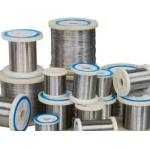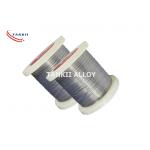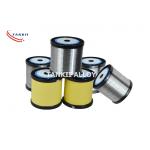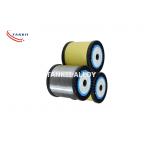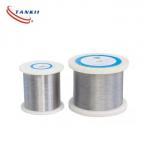Nickel 200 min 99% Purity Nickel Strip for Battery Building
Application 1.Product Description Ni 200 is a 99.6% pure wrought nickel alloy. Sold under the brand
names Nickel Alloy Ni-200, Commercially Pure Nickel, and Low Alloy
Nickel, Ni 200 offers users a wide range of benefits including its
primary component, nickel. Nickel is one of the world’s toughest
metals and imparts a number of advantages to this material. Ni 200
has excellent resistance to most corrosive and caustic
environments, media, alkalis, and acids (sulfuric, hydrochloric,
hydrofluoric). Used both in and outdoors, Ni 200 also has: The surface of the pure nickel strip should be smooth and clean
without wind layers, cracks, bubbles, spikes, bends and inclusions.
Minor local defects, such as scratches, spots, pits, dents, roll
marks, etc., that do not exceed the allowable deviation of the
strip thickness are allowed. Slight oxidation, blackening, and
slight local oil marks are not used as the basis for scrapping. Cut
strips on both sides without burrs, cracks, or curls. The strip
should be straight, but slight waves are allowed; the lateral bend
of the strip should not exceed 3 mm per meter. Pure nickel belts show good corrosion resistance in many acidic and
alkaline environments and are mainly used in reducing media. It has
good mechanical properties in a relatively wide temperature range
and is easy to cold work. Therefore, it is widely used in plate
heat exchangers, bellows compensation expansion joints, caustic
soda, chemical equipment, etc. However, in the actual production of
pure nickel strip, as with titanium strip coils, there are also
many technical difficulties in the annealing of the entire strip of
nickel strips. If the annealing temperature is too high and the
holding time is too long, the entire nickel belt roll is easily
annealed and bonded, but if the holding time is not enough, the
entire roll cannot be retracted. Therefore, low temperature and
long time annealing is an effective way to reduce the overall coil
annealing of nickel strip steel. 2. Properties
Name |
Nickel Strip |
Material |
Ni200, Ni201 |
Color |
bright, oxidized |
Size |
Dia 0.025mm-0.6mm Coil / Straight/Spool |
Standard |
ASTM B880-1988 |
Surface |
Polished |
Standard |
ASTM B160/B162, AISI,DIN,GB etc |
Application |
Electric apparatus, chemical, heating etc. |
Package |
Carton or wooden case as demanded |
Sample |
All in stock |
Certification |
Official Quality Certification and test report. |
Nickel 200/201 / UNS N02200 / W.Nr. 2.4060/2.4066 &
2.4061/2.4068DescriptionNickel 200 and Nickel 201 are solid solution strengthened,
commercially pure wrought alloys. The elemental restrictions of
both alloys are combined into one, dual-certified chemistry,
resulting in a single alloy with the desired characteristics of
both alloys. When operating temperatures are expected to exceed
600°F, carbon content becomes critical. The lower carbon content of
Nickel 201 makes the material resistant to graphitization and
therefore less subject to embrittlement. Pressure vessels and
components can be constructed from Nickel 201 according to the ASME
Boiler and Pressure Vessel Code, Section VIII, Division 1 for use
up to 1250°F. Industries and ApplicationsNickel 200/201 is used heavily in the chemical and electronics
industries. It is also used in the aerospace, petrochemical, power
generation and marine/offshore engineering industries. Typical
applications where Nickel 200/201 is used include electronic and
electroplating components, caustic evaporators, food processing
equipment, caustic handling and storage equipment, synthetic fiber
production, salt production and other processes where sodium
hydroxide and fluorine are used. Resistance to CorrosionNickel 200/201 offers excellent corrosion resistance in reducing
and neutral media as well as in oxidizing atmospheres, provided the
oxidizing media allows the formation of a passive oxide film. This
oxide film accounts for the alloy’s excellent resistance to
corrosion in caustic environments. Nickel 200/201 is often used in
environments containing alkalies, and it has varying use in
sulfuric, hydrochloric, anhydrous hydrofluoric and non-aerated
organic acids. Nickel 200/201 is resistant to stress corrosion
cracking in chloride salts and toattack from non-oxidizing halides.
Concentration and temperature can affect this alloys resistance in
certain environments. Fabrication and Heat TreatmentAll hot working and cold working practices can be utilized when
shaping Nickel 200/201. Hot working temperatures should be between
1200°F and 2250°F with heavy forming to be performed at
temperatures above 1600°F. Annealing should be performed at a
temperature between 1300°F and 1600°F. Care should be taken when
choosing the anneal temperature as time-at-temperature for this can
greatly influence the mechanical properties and structure of the
material. Common Trade NamesNickel 200, Nickel 201 <div class="vc_gitem-animated-block " "="" style="padding: 0px;
margin: 0px; position: relative;"> Chemical Composition (%)| (Ni) Nickel1 | 99.0 min | | (Fe) Iron | 0.40 max | | (Mn) Manganese | 0.35 max | | (Si) Silicon | 0.35 max | | (Cu) Copper | 0.25 max | | (C) Carbon | 0.02 max | | (S) Sulfur | 0.01 max |
Applicable Specifications*| Form | ASTM | ASME | | Bar1,2 | B160, B5643 | SB160, SB5643 | | Plate1,2 | B162 | SB162 | | Sheet1,2 | B162 | SB162 | | Seamless Tube & Pipe2,4 | B161 | SB161 |
1Hot worked/annealed. 2Dual certified to UNS N02200/N02201. 3Dual certified on diameters 3 1/2″ and larger (Nickel 200 only). 4Annealed.
*EN10204-3.1 applied to all product forms.
|



